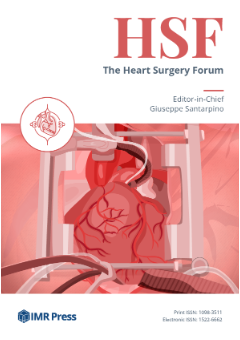Announcements
The Heart Surgery Forum (HSF) is published by IMR Press from Volume 28 Issue 9 (2025). Previous articles were published by another publisher under the CC-BY-NC licence, and they are hosted by IMR Press on imrpress.com as a courtesy and upon agreement.
Open Access
Article
A Novel Approach for Pain Management in Cardiac Surgery via Median Sternotomy: Bilateral Single-Shot Paravertebral Blocks
Heart Surg. Forum 2007, 10(5),
357–362;
https://doi.org/10.1532/HSF98.20071082
Published:
13 September 2007
Abstract
Regional analgesia has entered cardiac anesthesia in the form of spinal or epidural analgesia. However, the risk of spinal or epidural hematoma is a constant worry. Alternative regional techniques might be applicable in cardiac surgery. The purpose of this study is to present a novel technique of bilateral single-shot paravertebral blocks (BSS-PVB) for cardiac surgery via median sternotomy and compare its efficacy versus high thoracic epidural analgesia (TEA). Fifty-two patients were compared in this prospective cohort audit. In 26 patients, cardiac surgery was performed using low-dose fen-tanyl/BSS-PVB (bilateral blocks of 3 mL bupivacaine 0.5% each, T1-7) and general anesthesia; in another 26 patients, TEA (bupivacaine 0.125% at 10 mL/hour) and general anesthesia were used. Patients were assigned to cohorts according to their preoperative data and types of surgery. All patient data are shown as mean ± SD; pain scores were compared between groups using thettest immediately, 6 hours, and 24 hours after surgery (P< .05). In the BSS-PVB-group (19 men, 7 women), mean age was 65 ± 11 years, weight 74 ± 16 kg, ejection fraction 59% ± 12%, and duration of surgery 130 ± 27 minutes; in the TEA-group (17 men, 9 women), mean age was 63 ± 10 years, weight 75 ± 16 kg, ejection fraction 58% ± 12%, and duration of surgery 113 ± 27 minutes. These data and preoperative comorbidity variables were not significantly different between the two groups. In each group, 18 patients underwent off-pump coronary artery bypass grafting, 3 on-pump and 5 mitral valve replacements. All patients were successfully immediately extubated. Postoperative pain scores were at any point significantly lower with TEA, immediately at 2.4 ± 2.2 versus 3.7 ± 2.6, at 6 hours at 1.1 ± 1.5 versus 2.4 ± 1.8, and at 24 hours at 1.0 ± 1.4 versus 2.3 ± 1.6 (0 = no pain, 10 = maximum pain). There was no complications related to epidural catheter placement or BSS-PVB. Using both techniques, immediate extubation after cardiac surgery is feasible; TEA provides better pain relief after cardiac surgery than BSS-PVB.

